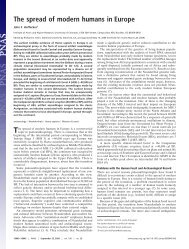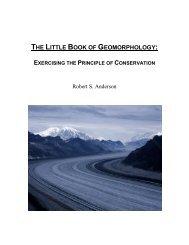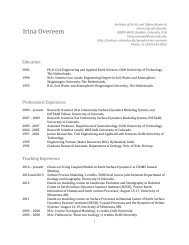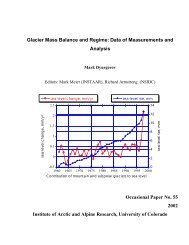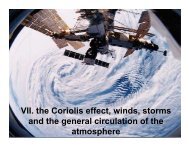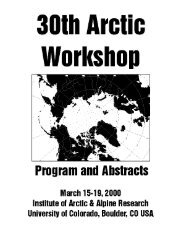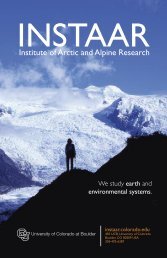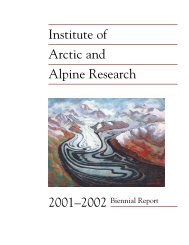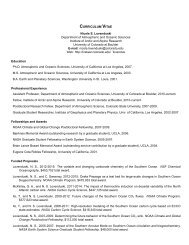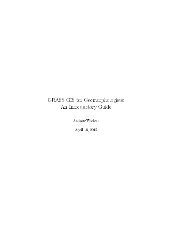00_cover_Biennial Report 05-06.qxd - INSTAAR - University of ...
00_cover_Biennial Report 05-06.qxd - INSTAAR - University of ...
00_cover_Biennial Report 05-06.qxd - INSTAAR - University of ...
- No tags were found...
Create successful ePaper yourself
Turn your PDF publications into a flip-book with our unique Google optimized e-Paper software.
<strong>INSTAAR</strong> LaboratoriesAmino Acid LaboratoryThe laboratory specializes in the extraction and quantification<strong>of</strong> amino acids that are derived from indigenous proteinaceousresidues preserved in biominerals for a range <strong>of</strong>environmental applications. Both quantitative amino acidcomposition and extent <strong>of</strong> racemization <strong>of</strong> several differentamino acids are targeted. The facility includes two HP-11<strong>00</strong>automated high-pressure liquid chromatographs (HPLCs)and ancillary support equipment. Usually one HPLC runs inreverse-phase mode and the other in ion-exchange mode.The laboratory currently focuses on the kinetics <strong>of</strong> aminoacid racemization in the eggshells <strong>of</strong> large flightless birdsfrom Australia, Madagascar, and Africa, and bivalve mollusksfrom high-latitude regions. The laboratory director isGifford Miller, with day-to-day operations overseen byStephen DeVogel. Graduate and undergraduate students usethe laboratory in their research projects and to gain researchexperience.AMS Radiocarbon Preparationand Research LaboratoryIn-house research focuses on method development in AMS14 C preparation and dating, calibration <strong>of</strong> the radiocarbontime scale, reconstruction <strong>of</strong> atmospheric and oceanic14 C activity in the past, and ultra-precise measurement <strong>of</strong>14 CO2 in the contemporary atmosphere. This laboratory isunder the direction <strong>of</strong> Scott Lehman.Atmospheric ResearchLaboratoryThis laboratory houses instrumentation for research onatmospheric chemistry, transport, and surface-atmospheretrace gas fluxes. This lab is heavily involved in field researchat continental, midlatitude sites as well as in the polarregions. The studies in snow-<strong>cover</strong>ed environments focuson the role <strong>of</strong> snow on surface fluxes <strong>of</strong> important atmospherictrace gases. A monitoring station on Pico Mountainin the Azores is equipped with a hydrocarbon monitor forinvestigations on the long-range transport <strong>of</strong> air pollutionacross the Atlantic Ocean. Another emphasis is the analysis<strong>of</strong> volatile organic compounds (VOC), in particular emissions<strong>of</strong> biogenic VOC from vegetation. Measurements aremade by solid adsorbent sampling techniques, thermaldesorption instruments, and several gas chromatographswith different detection systems, including flame ionizationand mass spectrometry. The global distribution <strong>of</strong> nonmethanehydrocarbons is investigated by analysis <strong>of</strong> airsamples that are collected within the framework <strong>of</strong> theNOAA Global Greenhouse Gas Monitoring Network.Another project involves deployment <strong>of</strong> eddy correlationflux instrumentation on the NOAA Ron Brown researchvessel for investigations on the uptake <strong>of</strong> ozone to theoceans. The Atmospheric Research Lab also pursuesresearch on boundary-layer dynamics and the vertical distribution<strong>of</strong> chemical species by vertical pr<strong>of</strong>ile measurementsusing a tethered balloon platform with various balloonbornemeteorological and chemical sensors. The laboratorydirector is Detlev Helmig.A flux experiment on loblolly pine trees, Duke Forest, NC, August2<strong>00</strong>5. <strong>INSTAAR</strong>’s Atmospheric Research Laboratory has beenstudying the emission <strong>of</strong> sesquiterpene compounds and theireffects on atmospheric aerosol production. Sesquiterpenes are biogenicorganic semi-volatile compounds released from vegetationfoliage. Photo: John Ortega (<strong>INSTAAR</strong>).Biogeochemistry Laboratories<strong>INSTAAR</strong> houses four laboratories that collectively areequipped to handle many <strong>of</strong> the major analytical techniquesin modern biogeochemistry. Chemical analyses <strong>of</strong> carbon,nitrogen, and phosphorus and multiple other elements inplants, soils, and water are routinely performed, as are avariety <strong>of</strong> microbial assays, a suite <strong>of</strong> chemical and opticalmeasurements <strong>of</strong> dissolved organic carbon, and GC- orIRGA-based measurements <strong>of</strong> several biogeochemically relevantgases. Beyond basic extraction and sample processingfacilities, major instrumentation includes (but is not limitedto): an autoanalyzer for N and P, atomic adsorption analyzerfor cations and metals, Carlo-Erba CHN analyzer, benchtopspectrophotometers and fluorometers, TOC/TN analyzers,and a TCD/FID gas chromatograph. The laboratories aresplit into individual direction by several <strong>INSTAAR</strong> faculty(McKnight, Townsend, Cleveland, Williams, and Seastedt)but function as a collaborative unit in many ways, includingin graduate research and education. They are consistentlyused by graduate students from <strong>INSTAAR</strong> and multipleother units across campus.16 | RESEARCH MISSION



